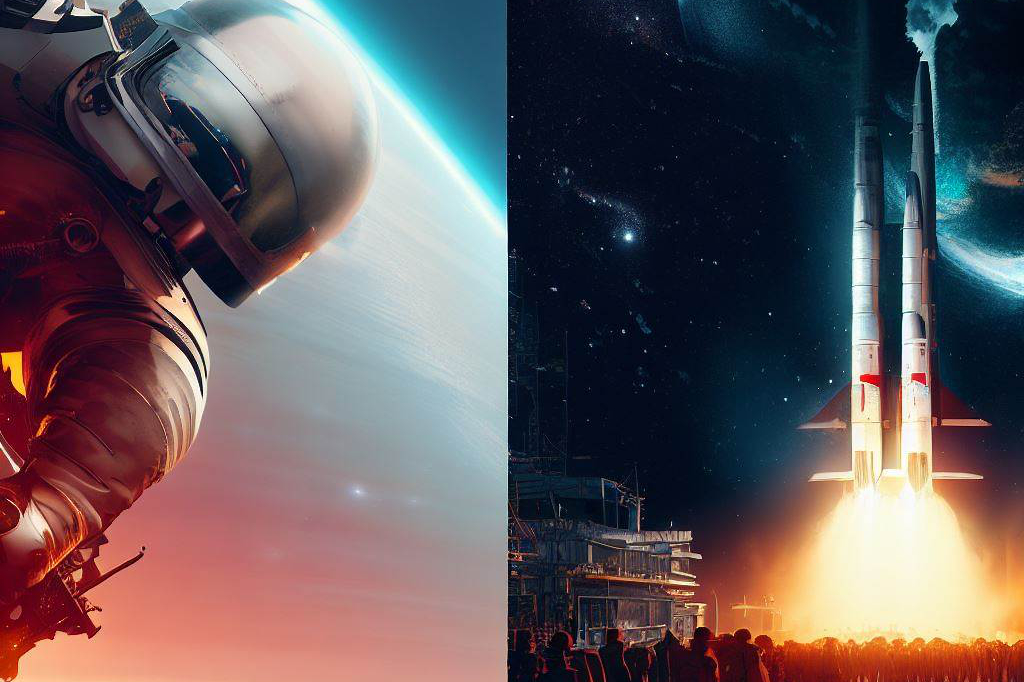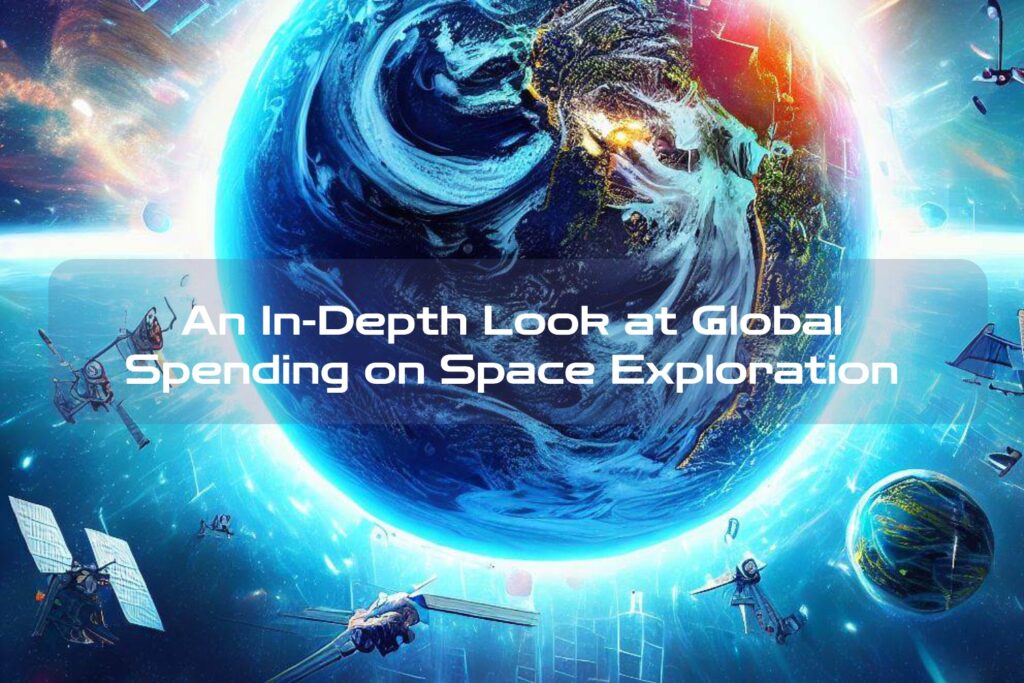Space exploration has been a subject of fascination for centuries, with explorers such as Galileo, Kepler, and Copernicus paving the way for modern space science. In recent years, space exploration has become a significant focus for many nations across the globe. The purpose of this article is to explore how much the average country spends on space exploration and how this budget is allocated.
Definition of Space Exploration
Space exploration is the process of exploring outer space through the use of manned and unmanned spacecraft. It encompasses various activities, including
- launching satellites into orbit,
- exploring planets and other celestial bodies,
- studying cosmic phenomena,
- and conducting experiments in microgravity.
Space exploration involves an interdisciplinary approach that combines elements from fields such as physics, astronomy, chemistry, biology, engineering, and computer science.
The Importance of Space Exploration

Space exploration has significant implications for humanity’s understanding of the universe and our place within it. By studying celestial bodies such as stars, planets, asteroids, comets, and galaxies, we can gain a better understanding of their composition and behavior, which can lead to advances in technology that benefit society in areas such as medicine or energy production.
Furthermore, space exploration enables us to monitor our own planet’s health by observing climate change patterns or natural disasters from above; thus helping us prepare for potential crises before they occur.
The study of space offers opportunities for international cooperation between governments with different political ideologies; allowing them to work together towards common goals.
Purpose Of The Article

The primary purpose of this article is to examine how much money countries are investing in space programs globally; specifically focusing on an overview comparison between countries with large budgets vs those with small ones. Additionally; we will investigate where these funds are allocated within each nation’s program, i.e., infrastructure development vs research vs technology development among other areas.
With that knowledge, we can gain insight into the priorities of different governments and how they are allocating their resources to this field.
Overview of Global Space Budgets
Space exploration has been a key area of investment for several countries around the world. The annual global spending on space exploration has been increasing over the years, with countries investing billions of dollars into this field. The budget allocation for space exploration not only varies across different regions but also varies within a country over time.
Comparison of Global Space Budgets

The United States emerged as the leader in space exploration when it launched its first satellite in 1958. Today, the US remains one of the largest investors in space technology, with an annual budget of over $40 billion.
However, there are other countries that have also increased their spending on space exploration.
In recent years, China and Russia have emerged as major players in this field.
China has increased its spending significantly and is now investing approximately $10 billion annually in space technology. Russia’s budget for this sector is approximately $5 billion annually and has experienced steady growth.
Other countries, such as India, Japan, and European nations, have also invested heavily in space technology in recent years. In 2020, India allocated $1.4 billion to its space agency, while Japan invested approximately $3 billion.
Countries with the Largest Space Budgets
The United States remains the country that spends the most money on space technology, followed by China and then Russia. Other notable spenders include France, Germany, India, and Japan. The US spends more than three times what China spends on their respective programs and roughly eight times what Russia invests in their program.
Trends in Global Space Budgets

In recent years, there has been an overall trend towards increased investment in exploring new frontiers beyond Earth’s orbit, including Mars colonization missions. There has also been a growing focus on private companies being involved in space exploration.
Companies such as SpaceX, Blue Origin, and Virgin Galactic have emerged as major players in the space industry, with their own ambitious plans for the future. While the US remains the dominant spender on space technology, other countries have emerged as major players, investing significant funds into their respective space programs.
The trend toward exploring new frontiers beyond Earth’s orbit is expected to continue in the coming years. Additionally, the growth of private companies in this sector will likely shape how space technology develops in the future.
How is the budget allocated?
Space exploration requires a huge amount of funding, and allocating the budget appropriately is essential to ensuring successful missions. The budget allocation for space exploration varies from country to country and largely depends on their priorities and goals. A significant portion of the budget is spent on research and development of advanced technologies such as spacecraft, launch vehicles, satellites, and ground infrastructure.
Breakdown of budget allocation for space exploration

A major portion of the budget allocated for space exploration goes towards building new spacecraft and developing technology that can withstand the harsh environment of outer space. It also includes
- building better telescopes,
- ground infrastructure like observation facilities,
- research labs,
- ground stations,
- satellite control centers,
- and data processing centers,
among other things.
Another significant part of the budget goes toward launching these spacecraft into orbit with powerful rockets. Building cutting-edge rockets that can lift heavy payloads into low-earth orbit requires large investments in Research & Development (R&D) activities.
Major areas where the budget is spent

The major areas where countries allocate their budgets are in manned missions or robotic missions.
Manned missions refer to sending astronauts into space, while robotic missions refer to sending machines or robots (without human crew) into space.
The US National Aeronautics and Space Administration (NASA) has been a pioneer in manned as well as robotic missions with its various programs such as Apollo mission that sent humans to Moon landing over 50 years ago. Similarly, the European Space Agency’s Rosetta Mission was a highly successful robotic mission launched in 2004 which landed a probe on Comet 67P/Churyumov-Gerasimenko in 2014 after traveling more than 4 billion miles around our solar system over ten years.
Examples of successful projects funded by these budgets

One example of a successful project funded by a country’s space budget is the Mars Exploration Program by NASA, which has deployed several rovers and landers on the Martian surface.
These missions have provided valuable information about the Red Planet, including its geology and potential for microbial life.
Another example is the Indian Space Research Organisation’s (ISRO) Mars Orbiter Mission, which was launched in 2013.
It made India the first country to successfully send an orbiter to Mars in its maiden attempt at a significantly lower cost than other countries.
Allocating funds towards space exploration requires careful consideration of a country’s priorities and goals.
Building new spacecraft, developing advanced technology that can withstand the harsh environments of outer space, and launching payloads into space with powerful rockets are some of the major areas where significant portions of budgets are allocated. Successful projects like NASA’s Mars Exploration Program or ISRO’s Mars Orbiter Mission demonstrate how investment in space exploration can lead to significant achievements in science and technology.
Factors Affecting Space Budgets

Political Factors Affecting Space Budgets: The Cold War and International Cooperation
Politics has been one of the major drivers of space exploration budgets for many countries.
During the Cold War, the United States and Soviet Union competed for dominance in space, leading to a significant increase in spending on space exploration by both nations. This political rivalry spurred many technological advancements and eventually led to a man landing on the moon.
Today, politics still play a crucial role in determining space budgets. Countries like China and India have increased their spending on space as they seek to establish themselves as global superpowers.
On the other hand, international cooperation has also had an impact on space budgets. Several countries have collaborated on major projects such as the International Space Station (ISS), which has allowed nations with smaller budgets to participate in significant missions while sharing costs with other partners.
Economic Factors Affecting Space Budgets: Funding Constraints and Economic Returns

Economic factors also influence funding for space exploration. Governments often face budget constraints and must prioritize funding between various sectors like healthcare, education, infrastructure, defense, and research. When faced with these decisions, it is often difficult for governments to justify investing large sums of money into a field that may not directly impact their economy or wellbeing.
However, there are potential economic returns from investing in space exploration that may justify such expenditures over time. For instance, spinoff technologies developed through NASA’s Apollo program led to significant advancements in computing technology that have since become ubiquitous in our daily lives today.
Technological Advancements and Their Impact on Budget Allocation: Automation & Privatization

Advancements in technology are another factor affecting how much countries spend on space exploration. One trend is towards automation; robotic spacecraft are becoming more capable of performing tasks that used to require human intervention, which is reducing the need for human-led missions and lowering costs.
Additionally, there has been a rise in private companies offering space exploration services, with companies like SpaceX and Blue Origin taking over some of the responsibilities that were traditionally performed by government agencies.
These changes have led to calls for a re-evaluation of how governments allocate space budgets. Some argue that governments should focus on developing technology and infrastructure that will enable private companies to lead space exploration efforts.
Others suggest a more flexible approach that allows for both public and private entities to work together towards common goals. Regardless of which approach is adopted, it is clear that technological advancements will continue to shape the future of space exploration budgets.
Final Thoughts

After analyzing the various countries’ space budgets and how they allocate them, it becomes clear that space exploration remains a vital aspect of scientific research and technological advancement. The budget allocation for space exploration varies depending on a nation’s political, economic, and social priorities.
However, despite different allocations, the common denominator is that all countries that invest in space exploration reap immense benefits from their investments. Space exploration has led to breakthroughs in
- medical science,
- telecommunication technology,
- environmental monitoring and mapping,
as well as Earth observation capabilities.
It has also contributed to advancements in astrophysics by providing deeper insights into our universe’s origins and composition. Additionally, investment in space technology has created job opportunities for scientists and engineers while boosting the economy.
The Future Outlook on Global Spending on Space Exploration
The future outlook for global spending on Space Exploration looks promising given its multi-dimensional contributions to society.
Governments worldwide seek to increase their investments further in this field as they see its potential for driving innovation across multiple sectors beyond scientific pursuits alone. However, it must be noted that risks exist regarding how funds are allocated, both within nations themselves and between international partners in collaborative projects.
Thus, future spending must remain responsible and transparent while being backed by strong scientific and economic evidence. Advancements in technology mean that the costs associated with space exploration are reducing, opening new doors for new entrants into this field.
Private companies like SpaceX, Blue Origin, and Virgin Galactic are already making strides within this industry by developing reusable spacecraft that make space travel more affordable. With continued investment in space exploration globally, we can expect to see more profound advancements in science and technology while creating a positive ripple effect on the economy.
—
The comparison and analysis of global space budgets presented in this article were sourced from reputable publications such as the World Economic Forum, Forbes, and Space News. These publications provided data on countries with the highest space budgets, trends over time, and insights into how these budgets are allocated.
Budget Allocation for Space Exploration
To provide a breakdown of budget allocation for space exploration, this article relied on primary research as well as secondary sources such as NASA’s website, the European Space Agency (ESA), and The Planetary Society.
These sources provided detailed information on where the budget is spent and the major areas that receive funding, such as spacecraft development, research programs, and launch facilities, among others.
Factors Affecting Space Budgets
The political factors affecting space budgets were sourced from academic journals such as Space Policy Journal and comparative studies by international organizations such as OECD.
The economic factors affecting space budgets were also sourced from similar comparative studies by international organizations such as OECD (Organization for Economic Cooperation and Development) which combines data from various countries to provide insights into economic trends over time.
The analysis of technological advancements was based on scientific articles published in peer-reviewed journals such as Nature Astronomy.
The above references provided reliable sources used to develop the content for this article, enabling readers to have an informed overview of global spending on space exploration today.

C M, a seasoned editor, journalist, and consultant, is deeply fascinated by the convergence of technology, space, and the future of humanity.
With a particular interest in transhumanity, futurology, and the philosophical and ethical dimensions of these domains, C M serves as the lead contributor to SpaceSpotlight and TranscendSphere.
When not penning insightful articles on these rapidly evolving fields, C M indulges in their love for podcasts and books, proudly embracing their status as a ‘Happy Nerd Extraordinaire!’



